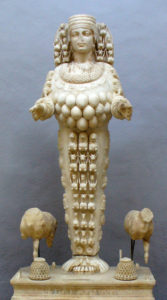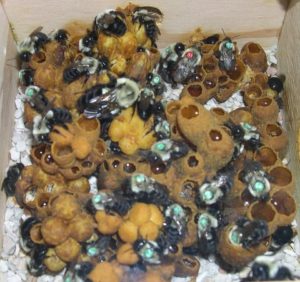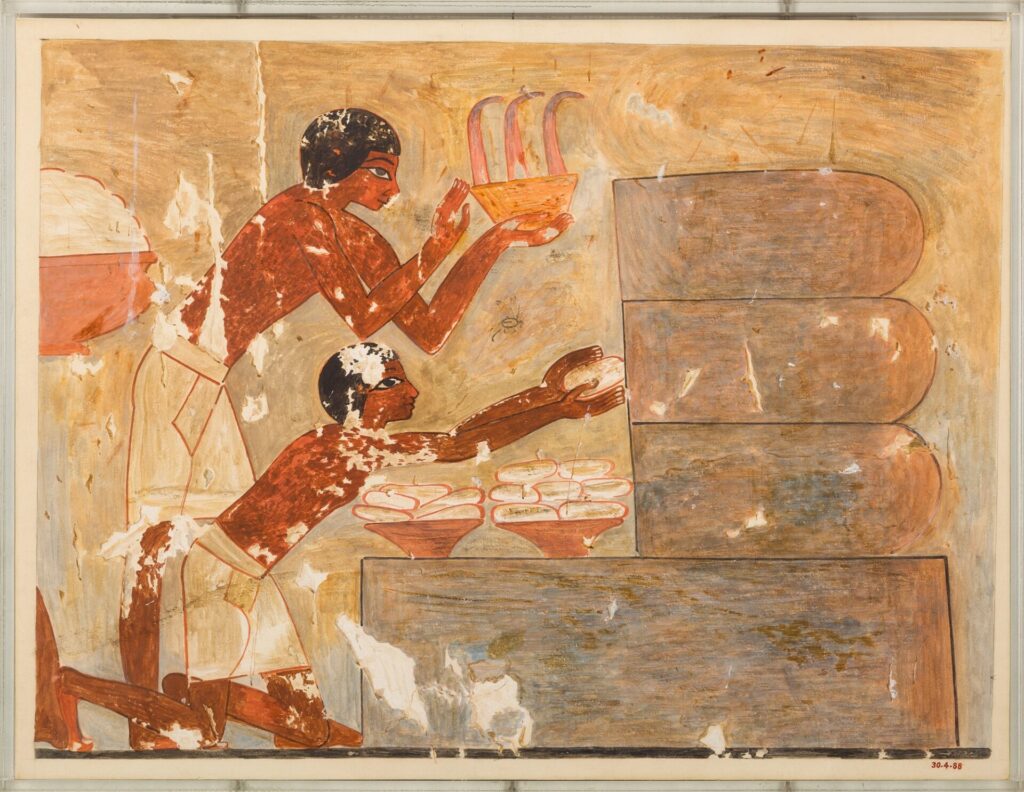Bees in Greek myth.
As we have seen in the previous article, apiculture had become a sophisticated industry by the time Homer was composing epithets and gruesome deaths. The Mediterranean and its trade routes facilitated an easy exchange of ideas and technologies. One civilisation, the Minoan may well have passed on technologies or offered alternatives to those already used by those on the Peloponnese.
Crete, home to the Minoans, identified the bee with the Olympian deities from very early on. While the infant Zeus lay in his cave on the island and evaded the hunger pangs of his father he was fed honey by bees. From this episode a number of apiarian myths buzz about the place. The first was that the three deities who fed the infant were the Thrai, who sound very similar to the deities who give Apollo his gift of prophecy in his Homeric Hymn.
Other myths point to an individual called Melliseus (bee-man) or his daughter Melissa (bee) and both seem associated with the invention of fermented honey as a drink. Then there was the Minoan Goddess figure, herself identified with the bee and whose priestesses were called ‘Melissa’. We’ll see this name cropping up elsewhere later.
Where etymology and entomology become blurred we can turn our attention to something more tangible. The palace complex of Knossos is a marvel and within this sits a room known as ‘The Snake Room’ (a place even Indiana Jones would have avoided). The room obtained its serpentine name because the early archaeologists were quick to view the objects in it as being linked to the worship of a snake goddess, yet this may not be the case.
One argument put forward by Haralampos & Anastasios Harissis posits that many of the items relate to apiculture. The objects such as wax collectors and smokers have been wrongly interpreted as being linked to snakes.
The relationship between deity and bee wasn’t just the preserve of Crete. Ephesus was a Greek colony established in the 10th century BC, a good 500 years after the Minoan society had effectively ended. Artemis came to replace the previous deity, Kybele who was worshipped as a mother goddess.

Ephesian Artemis from Ephesus
The cult of Artemis took hold but it wasn’t without references to the one which had preceded it. The famous statue of Artemis at Ephesus isn’t of some young virgin on tiptoe with a bow held in delicate fashion. It’s a rather more complex facade, a bizarre mix of outlines and shapes. Without doubt the eye is drawn to the collection of spheres hanging round the chest of the goddess. Were these breasts? If so did this reference the earlier worship of Kybele?
There is another possibility which considers the nests of bumblebees as an inspiration for these globes. Larvae develop in small spherical structures which cluster together (see below).

Stefanos Skarmintzos argued a sequence of events which gives a different explanation. Once a wooden figure of the earlier deity stood in this area. A colony of bumblebees attached itself to the statue or figure (it didn’t even need to be a crafted idol; in Samos Hera was represented in an archaic ceremony by a plank of wood). The locals may have seen this as a mark of the divine. This wouldn’t be out of the ordinary, the citizens of Amathus on Cyprus took a decapitated head which had been used as an impromptu hive by bees as a sign they needed to make a sacrifice to its owner. This was potentially awkward as it was the Amathusians who had carried out the decapitation in the first place (Herod.5.114).
What is argued is that the earlier worshipped image tracked across to the Artemis when she became the lead deity. The larvae were then added or became a feature of her image. It’s an interesting idea and it’s not as if bees weren’t evident elsewhere at Ephesus.
Young girls who served there were known as Melissa and a senior official was known as the ‘King Bee’. There’s certainly a whiff of something apiarian at Ephesus and it’s not simply from the smoker’s pot.

Ephesian coin with a bee, dating to the 4th century BC
From the fanciful we can certainly bear witness to the bee as an icon of Ephesus, certainly by the Classical Period. Ephesian hoplites displayed the image of a bee on their shields and even the currency featured it. This doesn’t prove anything in relation to the mysterious spheres adorning the Ephesian Artemis, but it does point to a culture where the bee had strong connections, from the religious to the military and even the commercial. At the other end of the Mediterranean apiculture was also a technology as least as capable as anywhere else. In southern Spain, near Valencia a number of the cylinder-hives were found (around 78 sites in total). Some built into walls in outhouses, others on roofs. By the 3rd century BC this area had developed a name for itself as the provider of fine honey as later writers would testify.
Like ancient (as well as modern) wine the appreciation of honey had risen to the extent where certain areas became synonymous with quality. Though southern Spain was highly regarded we travel to mainland Greece to find the honey held in the highest regard. In Attica sits Mount Hymettus, according to Aesop it’s here that the bee got its sting. Zeus, in a worrying display of affection for man realised that the gift of the sting needed a check and balance. The life of the bee would be forfeit when it used its new weapon, which would save humankind suffering but still offer the bee some sort of protection.
Promises affecting mankind made on mountains by deities isn’t something specific to the Greek pantheon, but that aside Hymettus did claim supremacy in the quality of the honey which could be farmed there. In the western foothills at a location known as Alepovouni a large number of inscriptions were found carved into the bedrock. Most are dated to the first century BC and mostly read ‘horos’. The assumption is that these are boundary markers as found elsewhere. What is unusual here is that they occur in a large number, more than would be expected and one archaeologist, Josiah Oher, has argued that these were markers for hives.
In a space where a high quality brand of honey could be harvested it makes sense that owners of the land ensure that their hives were assured of a spot and that rival hives didn’t end up where they shouldn’t. Suddenly those Hittite laws seem increasingly more sensible.
These markings date to the Roman period (1st century BC) but we have plenty of reference to honey cited in the works of the Classical Period. Honey cakes or honey itself as an offering was common place, this will form the meat of the next article so I won’t go into these too much, however there are other examples. Aristophanes mentions honey sellers (Knights.834) the expensive nature of Attic honey (Peace.250) and even its usefulness in stopping a child crying (Thes.466). Needless to say Herodotus pitches in, advising that Gyzantes in Libya made large quantities of honey (4.194) and offering a warning not to cross the Danube for fear of monster bees (5.10). To be fair even Herodotus doesn’t believe the point about giant bees, but it’s too juicy to leave out.
Elsewhere honey and bees feature far more in the domestic than the fantastic. Xenophon’s Oeconomicus features the Queen Bee as a role model for any new wife and Plato sends Dionysus of Syracuse a few jars of honey (presumably the good Attic stuff). We’ve seen honey as a gift elsewhere, as tribute to Thutmose III. There’s even the suggestion that Joseph, he of technicolour robe fame, received jars of honey as gifts from his father who was unaware of his son’s identity (Josephus. Ant.2.111).
Apiculture is dealt with in Varro’s work on agriculture (book 3), which dates to the first century BC. Amongst a general discussion concerning how best to situate and look after a hive Varro is quick to point out how bees taught men to manufacture, build and store food. Going one step further bees have an admirably organised society. In the context of commerce it’s Varro who gives figures and really fleshes out why those later boundary markers on Mount Hymettus (and even those early Hittite hive laws) may have been required.
Apiculture was a very good way to make money and Varro informs us of two impoverished brothers who were left some land and made 10,000 sercestes a year whilst another exported a sizeable amount (5,000 lbs). Perhaps where Rome took apiculture in a new step was the ability to literally map the industry onto the growing network of trade routes it controlled. Little wonder that honey was one of the items listed by Cicero as being pilfered by Verres from Sicily in the famous legal case against the former governor.
Honey as a weapon.
Rome had secured these trade routes through war and conquest, and where honey was very profitable it could also be equally as costly, though not necessarily in a commercial sense. Rome had experience of the sweet stuff in war and it left a bitter taste in the mouth.
The year was 65 BC and an army, led by Pompey, was chasing Mithridates deep in darkest Pontus (modern day Turkey – specifically near the Black sea coast). It was a dangerous march, the Heptakometes were the fierce local tribe kept the Romans alert. As with any army the rations were supplemented with what could be caught so when Pompey’s men stumbled upon a series of bowls stacked with dripping honeycombs the assumption was that they’d interrupted a normal harvest and helped themselves to a free lunch. Of course, there is no such thing as a free lunch.
What the Romans didn’t know was that the honey had been deliberately left for them by the Heptakometes. Honey in this region was often made using the pollen from two types of rhododendron native to the area and contains grayanotoxins, which, given that they contain the word ‘toxin’ is not good to ingest. In fact it’s not good to even touch, one modern test for honey with this in it is to rub a small amount on the palm of your hand. If it does contain the toxins your hand will start to tingle and you might have some numbness in your fingers.
For those who partook in the original honey trap the effects would be vomiting, nausea and possible temporary paralysis. Death is not common but the disabling nature of the condition was all that the returning Heptakometes needed in order to butcher some three maniples of legionaries.
The effects of the honey in this area had been noted by Xenophon during his grand march (Ana 4.8) and later Pliny even recommended its use for both sunburn and digestive problems (NH.4:342). The Greeks of the time called it maenomenon ‘mad honey’ and it was something to be feared. Used in moderation the honey can be used to treat a number of problems, from digestive issues to sexual dysfunction. It may have been that some Romans died with a smile on their faces at least.
Bees and politics.
With the Romans being savaged by the mischievous honeycomb they were certainly less naive when it came to the political ramifications of the bee and more importantly the hive. It’s a neat coincidence which sees an early use of bee imagery used by Homer in both the context of the political and martial. Following a call to arms from Nestor at a meeting the men “swarmed like bees that sally from some hollow cave” (II.2.89). Here are men inspired by a political rally and into the battlefield. Later writers were also to note the organisation of the hive and the potential of it. In Cyropaedia a lackey addressing Cyrus suggests his master is as born to rule as is the King bee (5.1.24).
It’s unlikely the political setup of the hive found much favour with the Greeks, an antithesis to democracy which saw a King anointed by birthright. Little wonder that Xenophon places such a comparison in the palace of a Persian king.
The Romans weren’t particular fans of kings either, yet Pliny in his Natural History (XI.11-55) has a literary love-in with the hive and the noble bee which surpasses the earlier admiration from Cato. The hive is compared to a military camp with scouts, builders and even guards. Bees have sound government and manners, they are industrious, logistically minded and even have a proper attitude to slaves (as per the treatment administered to drones). The Queen, well, she has a dedicated set of officials and it might be this last part which gives us a clue as to why this apparently very un-Roman hierarchy was considered so virtuous.
I’d argue that Pliny wasn’t advocating a monarchy, but found the order and stratification of the hive so attractive. The Queen wasn’t a monarch, but representative of the higher social order or Senate. Looking at it this way there’s an appreciation that you knew your place and just got on with it. The hive could therefore be both a Roman camp and the idealised social structure. But I may well be indulging myself, Pliny and the humble bee a tad too much, so we’ll move on to an earlier dialogue involving the bee and a Roman writer. This time it’s the poet Virgil and his the fourth poem in his Georgics.
Virgil writes largely on the way of attracting bees back to your farm through a ritual known as the bugonia. This involved killing a bull and leaving it for a number of days after which the bees would emerge from the animal and voila, your hive would be replenished. As you might expect there’s more going on here. To start with the poem states Aristaeus as a Greek beekeeping deity and places him firmly in the apicultural pantheon. Aristaeus lost his bees as a result of chasing Eurydice who had her foot bitten by a snake whilst escaping. Her vengeance from beyond the grave is the problem as Aristaeus finds out and the bugonia was the solution.
El-Nowieemy in a paper on the poem makes some interesting points concerning the above, the first is that the bugonia represents the birth of the new Roman state under Augustus. The new hive isn’t created from nothing. It’s the result of sacrifice and perhaps the bloodshed suffered by the bull is akin to that spilled during the civil wars and Augustus’ rise to power. Far from a denial of it, the strife itself is a requirement to create the new generation.
The second point refers back to an attribute afforded to the bee made earlier. At Ephesus the bee was closely allied to Artemis whose virginity was central to her worship and identity. Here an act borne of lust (Aristaeus’ pursuit of Eurydice) results in the loss of bees. Bees seem to have been associated with chastity and purity.
In Virgil’s account of the bugonia bees are also associated with birth and death, yet also carries the theme of purity which links in with the worship of Artemis at Ephesus (Artemis being a virgin goddess). What is fascinating is how apiculture extended from the economical and practical into the more abstract and political contexts.
It’s also wonderful on toast!




An excellent post. As an entomologist who has studied bees, I would suggest that bumble bees are an unlikely source for the Artemis statue. Their colonies are only formed underground, not on structures the way honeybees will do. The lumps might more likely be the oblong clay beehives used at this time. Depending on how wide spread apicultural knowledge was at the time, they could even be “queen cells”. Honeybees rear their queens in special, hanging, larger wax cells that they build off of the comb.
You’ve confused Cato and Varro as sources for Roman apiculture – the anecdote about the two brothers, and most of the other information, comes from Varro.
I blame too much/little coffe when editing this! Thanks for the input, I’ve made the amendment
thanks!
Thanks Paul, great insight as ever! I thought it was an interesting argument offered up.
You did a great job. Have you ever kept bees?
sadly no, though after doing the articles I realised how rewarding it must be.
Awsome blog! I am loving it!! Will come back again. I am taking your feeds also.
of course!